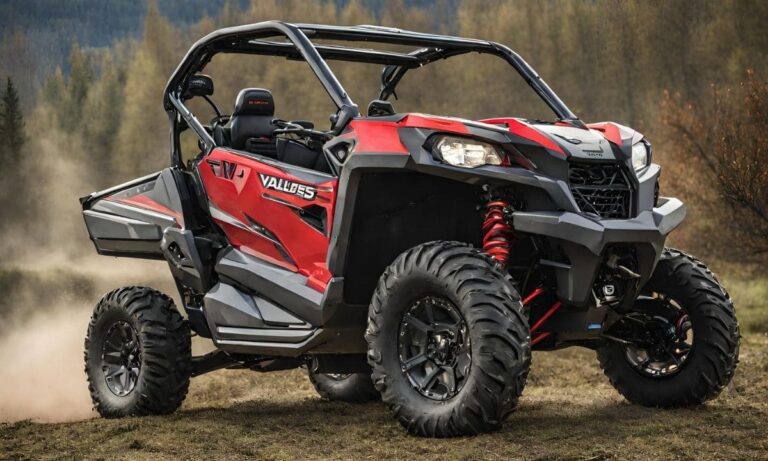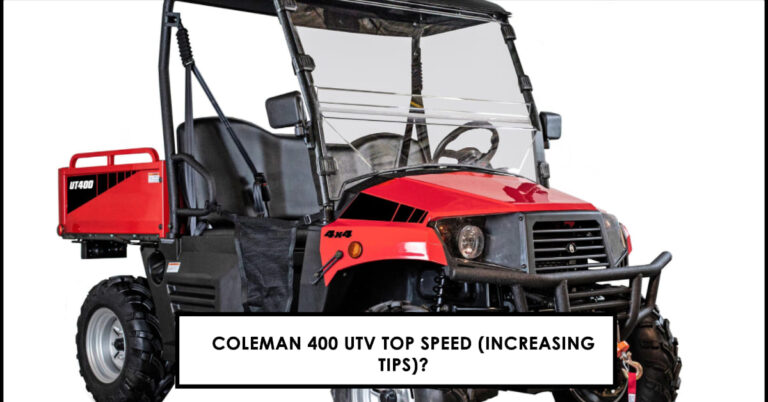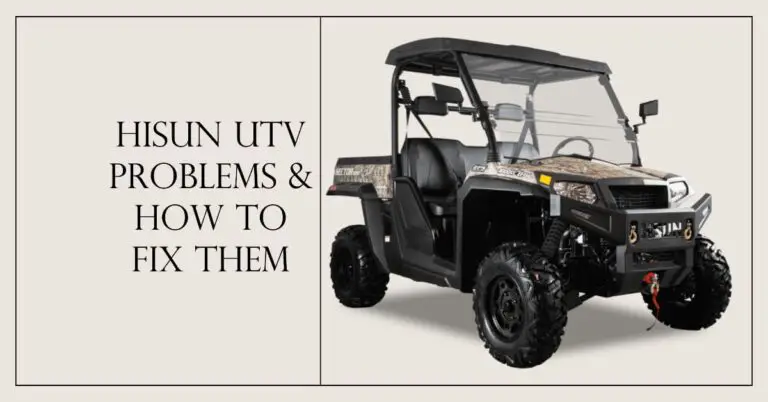Arctic Cat Wildcat 1000 Problems – Causes & How to Fix Them

The Arctic Cat Wildcat 1000 is widely considered one of the most capable and exciting high performance sport UTVs (utility task vehicles) on the market. With its potent 999cc V-twin engine churning out impressive horsepower paired with a rugged chassis and suspension suited for blasting across tough terrain, many off-roading enthusiasts have embraced the Wildcat 1000 as their side-by-side of choice for tackling extreme trails.
But even well-engineered UTVs like the Wildcat 1000 can develop issues over time. What are the most common Wildcat 1000 problems reported by owners and how can you diagnose and fix them?
In general, Arctic Cat Wildcats are robustly constructed and hold up nicely to aggressive recreational use. However like any machine, they still require regular maintenance and care to prevent premature wear and breakdowns. By being aware of the key problem areas on the Wildcat 1000 and quickly addressing any issues that emerge, you can keep your high performance UTV running optimally for years of off-road enjoyment.
In this detailed guide, we will cover the most common problems experienced by Arctic Cat Wildcat 1000 owners, including issues with the:
- Engine (overheating, misfires, oil consumption, etc)
- Transmission (slipping, hard shifts, leaks)
- Suspension and drivetrain components
- Steering, electrical and other parts
For each problematic area, we will discuss the typical symptoms owners notice when trouble arises, explain what is causing the issue, and provide tips to diagnose and repair the problem. We will also offer some general maintenance advice to help maximize the longevity and performance of your Wildcat 1000.
So if you own a Wildcat 1000 or are considering purchasing one, read on to learn how to recognize, troubleshoot and fix the most common problems with Arctic Cat’s popular sport UTV.
Table of Contents
Engine Problems in the Arctic Cat Wildcat 1000
Let’s start by looking at some of the typical engine issues that can crop up on the Arctic Cat Wildcat 1000. The Wildcat 1000 is powered by a 999cc, DOHC parallel twin cylinder engine putting out an impressive 100 horsepower, allowing the side-by-side to reach speeds over 60 mph.
This muscular V-twin power plant provides incredible acceleration and torque for conquering tough trails. However, even a sturdily built engine like the one found in the Wildcat 1000 is susceptible to certain problems over time, especially if maintenance is neglected.
Some of the most common Arctic Cat Wildcat 1000 engine issues include:
Overheating Problems
Excessive engine heat is one of the most frequently reported engine problems on the Wildcat 1000. A UTV’s cooling system relies on adequate coolant flow through the radiator and engine block to maintain proper operating temperature. Overheating issues can arise when:
- Coolant is low or contaminated leading to reduced heat transfer
- The radiator cap fails resulting in coolant loss/low pressure
- The water pump impeller deteriorates impairing circulation
- The thermostat sticks closed preventing coolant from flowing into the radiator
- Debris clogs the radiator reducing airflow
- Fan failure hinders air flow through the radiator
Signs of Wildcat 1000 engine overheating include:
- High engine temperature gauge reading
- Steam or coolant escaping from the radiator
- Overflow/degas bottle boiling over
- Sweet smelling exhaust indicating coolant burning in the cylinders
To diagnose and fix overheating, carefully inspect the cooling system components – radiator cap, coolant level, water pump, thermostat, hoses. Look for leaks, clogs and failed parts, replacing any as needed. Flush the system to remove contaminated coolant. Check the fan operation. Remove debris blocking air flow through the radiator.
Engine Misfires
Sporadic misfires as the engine is running can originate from several root causes:
- Fouled or damaged spark plugs
- Defective ignition coil or wires
- Clogged fuel injectors or weak fuel pump
- Vacuum leaks sucking air into the intake manifold
- Loss of compression in one cylinder
Symptoms of engine misfires usually include:
- Power loss, hesitation or sputtering as the engine runs
- Rough idle with the engine shaking more than normal
- Backfiring or popping noises from the exhaust
To troubleshoot misfires:
First, replace the spark plugs and inspect ignition wires for damage, corrosion and loose connections. Check for intake manifold vacuum leaks. Test the fuel injectors and fuel pressure – clean dirty injectors and repair fuel pump/filter if pressure is too low.
If those steps don’t cure the misfiring, a compression test can determine if you have leaking piston rings or faulty valves allowing compression loss in a cylinder. Rebuilding the top end may be needed in that scenario. An engine misfire detector can help pinpoint the faulty cylinder(s) as well.
Loss of Engine Power
Over time, Wildcat 1000 owners may notice a decline in the engine’s normal peppiness and power output. Among the common causes are:
- Clogged air filter restricting airflow into the engine
- Failing fuel pump providing insufficient fuel pressure
- Dirty fuel injectors not atomizing fuel properly
- Exhaust leak ahead of the oxygen sensor causing a too-lean condition
- Fouled spark plugs misfiring under load
- Loss of compression from worn piston rings or leaking valves
- Camshaft timing chain stretch throwing off valve timing
To investigate diminished power concerns:
Start by replacing the air filter and inspecting the fuel system – check fuel pressure at the rail, clean/replace clogged injectors, test the fuel pump operation. Install fresh spark plugs gapped to spec. Check for intake or exhaust leaks.
A compression test or leak down test can verify if piston rings, cylinders or valves have excessive wear allowing compression loss under load. The cam timing chain should be inspected as well. Proper timing is crucial for optimal torque and power output.
Oil Consumption
Owners may notice the Wildcat 1000 seems to burn more oil between changes than expected. Some seepage past worn seals and gaskets is normal as an engine accumulates mileage. But excessive oil consumption points to bigger issues like:
- Worn piston rings allowing oil to leak past into the combustion chamber
- Damaged or stuck piston ring lands preventing good seal
- Excessive cylinder bore wear from abrasive dirt ingestion
- Breather system faults sucking oil into the intake tract
- Failed valve stem seals causing oil to burn in the cylinder
To determine the cause of high oil usage in a Wildcat 1000:
Start by checking for external leaks near the valve cover, oil pan, rear main seal and other areas. Then conduct a compression or leak down test to measure cylinder sealing – worn rings or cylinders will show low compression.
Inspecting the piston crowns and cylinder bores with a borescope can reveal worn ring lands or excessive cylinder scoring. A thicker than normal oil film on the spark plugs also indicates ring seal problems. Fixing excessive oil burn will ultimately require engine disassembly to replace piston rings and hone or re-bore the cylinders.
Arctic Cat Wildcat 1000 Starting Problems
Difficulty getting your Wildcat 1000 to start, especially after it has been running fine, is another common grievance:
- Weak or dead battery – Charge battery and test its condition. Replace if necessary.
- Corroded battery connections – Clean or replace damaged battery cables/terminals.
- Faulty starter solenoid – Bypasses current when energized. Tap solenoid with hammer to test.
- Damaged starter motor – If worn, draws excessive current, overheats. Bench test starter amp draw.
- Bad ignition switch – Intermittently fails to activate starter. Test switch and electrical connections.
- Low starter relay failure – Stop providing voltage to the starter solenoid. Replace relay.
For diagnosis, pay attention to any clicks, grinding or whining during cranking to pinpoint the fault. Removing and testing starter system components may be needed to identify the specific problem part.
Transmission Problems in the Arctic Cat Wildcat 1000
The Arctic Cat Wildcat 1000 uses a sequential shift 5-speed automatic transmission designed and built by Team Industries. This transmission transfers the abundant power from the big twin engine to the wheels. Like any drivetrain component, the Wildcat’s transmission is subjected to considerable loads when driven aggressively in harsh conditions.
Some common Arctic Cat Wildcat 1000 transmission issues include:
Hard Shifting
The Wildcat 1000 will firmly shift between gears under hard acceleration. But owners may complain of overly harsh, abrupt shifts, especially as the vehicle accumulates miles.
What causes rough shifting?
- Low/contaminated transmission fluid – Inspect level and condition. Change fluid/filter.
- Worn shift cables – Cables stretch over time, affecting shift timing and feel. Replace worn shift cables.
- Faulty temperature sensor – Incorrectly tells transmission to firm up shifts. Test sensor operation and wiring.
- Solenoid issues – Sticking solenoids give uneven, delayed shifts. Test solenoids, clean or replace.
- Shift drum grooves burred – Can hang up shift forks causing abrupt engagement. Inspect drum grooves for damage.
To smooth out rough shifts, start by ensuring transmission fluid is clean and at the proper level. Adjust or replace the shift cables. Test sensors and solenoids that influence shift characteristics. The transmission may need to be opened up to inspect hard parts like drums, shafts and forks if problems persist.
Transmission Slipping
Transmission slippage occurs when the clutches fail to fully engage with the spinning shaft and flywheel. This allows the engine RPM to surge without a corresponding increase in vehicle speed. Causes of Wildcat 1000 transmission slipping include:
- Low fluid level or inadequate pressure – Top off fluid. Examine pump.
- Clutch plates worn smooth – Plates need to be replaced to restore grip.
- Glazed or warped steel friction plates – Requires replacement of plates.
- Swollen/cracked rubber transmission belts – Belts should be replaced.
- Clutch springs weaken – Can’t apply proper clamping force as designed.
- Shift fork bent or binding – Forks must slide smoothly to engage gears.
If your Wildcat 1000 transmission starts slipping, the fluid and clutch packs will need thorough inspection. Filter debris can indicate clutch or internal damage. Often a transmission rebuild or replacement is required to correct chronic slippage.
Transmission Leaks
Another common problem is the Wildcat’s transmission leaking fluid either externally or internally:
External Leaks
- Input/output shaft seals worn or damaged
- Gasket failure at case mating surfaces
- Loose fluid lines
- Cracked transmission housing
Internal Leaks
- Leaking front pump seal
- Porous casting allowing fluid seepage
- Breather blowing fluid out when overfilled
To address leaks:
Carefully clean and degrease the transmission to locate external leaks. Replace any worn seals and gaskets. Torque case bolts to spec. For internal leaks, the transmission must be disassembled and inspected – pump seals, casting porosity and other hidden issues can then be identified and repaired.
Overheating Issues
The Wildcat 1000 transmission operates under high loads and temperatures produced by the powerful engine. Overheating problems can develop when:
- Low fluid level or old fluid – Maintain proper level. Change fluid/filter regularly.
- Cooling lines blocked – Flush lines to ensure unobstructed fluid flow.
- Damaged external cooler – Inspect external transmission cooler for cracks/leaks.
- Cooler fan failure – Test fan operation, repair or replace as needed.
- Stuck thermostat or temp sensor – Replace faulty cooling system components.
If overheating occurs, immediately park the Wildcat and allow the transmission to cool down. Determine if the issue is internal slippage or inadequate cooling before resuming operation to avoid further damage.
Transmission Clutch Chatter
A vibrating, shaking sensation when accelerating accompanied by a rattling noise is referred to as clutch chatter. This annoying drivetrain vibration occurs when the clutch plates are not mating smoothly. Causes include:
- Extremely worn clutch plates – Replace warped or smooth plates.
- Oil contamination of clutch disks – Clean contaminated plates or replace.
- Damaged or missing drive/driven lugs – Can force plates out of alignment.
- Weak damper springs – Allows plates to oscillate.
- Bent clutch push or drive rods – Can prevent smooth engagement.
To eliminate chatter, inspect the transmission fluid for glazing or foreign material. Replace any damaged, warped or worn clutch disks. Verify proper clutch spring installation and function. Straighten or replace bent actuator rods.
Arctic Cat Wildcat 1000 Suspension Problems
The Arctic Cat Wildcat 1000 uses a race-inspired suspension system designed for responsive handling and a plush ride across rough terrain. Dual A-arm suspension provides 10-inches of front wheel travel, while trailing arms allow 10 inches of rear wheel travel. But even heavy duty suspension components experience wear.
Some common Arctic Cat Wildcat 1000 suspension and drivetrain problems include:
Leaking Shocks
The most reported suspension issue on the Wildcat 1000 is leaking shocks. The twin FOX Podium shocks feature high pressure nitrogen charged reservoirs. When seals fail, the gas escapes and the shocks lose their damping capability.
Typical leaking shock symptoms include:
- Rear sagging down
- Bouncy ride and loss of control
- Excessive bottoming out over bumps
- Visible fluid around the shaft seals
To fix leaking Wildcat shocks:
- Replace the shaft seals and any damaged dust seals
- Refill with FOX Gold fluid to the correct level
- Re-pressurize the shock reservoirs with nitrogen to spec
Neglected leaky shocks will require a full rebuild or replacement. Catching seal issues early is key to preventing permanent damage.
Worn Control Arm Bushings
The pivot bushings in the A-arm control arms gradually wear from flexing under suspension movement. This allows play between the arms and frame causing steering wander.
Signs of worn control arm bushings include:
- Sloppy or loose feeling front end
- Wandering at highway speeds
- Uneven tire tread wear
- Knocking noises over bumps
To repair, the old bushings must be pressed out and new ones installed. A bushing replacement kit is readily available for the Wildcat 1000.
Ball Joint Wear
Like any UTV, the constant impacts from rugged terrain take a toll on the Wildcat 1000’s ball joints. If not inspected and replaced, worn joints can separate resulting in steering loss and crash risk.
Clues of compromised ball joints include:
- Steering wandering or shimmy
- Clunks or pops when turning at low speeds
- Visible looseness or torn boots upon inspection
- Extreme wheel camber from dropped joints
Catch failing ball joints before complete failure by regularly checking for play and torn boots. Replace any loose or damaged joints.
Driveline Vibration
A vibrating driveline at certain speeds points to an out of balance propshaft or CV joint issues:
- Bent propshaft – Remove and have realigned or replace
- Worn U-joints – Replace bad U-joints
- Torn CV boots – Allow dirt ingestion damaging CV joints. Replace boots and inspect joints.
Isolate the source of driveline vibration by inspecting components as the Wildcat is driven. Rebalance or replace parts as needed.
Wheel Bearing Failure
Wheel bearings endure substantial side loads while cornering and impacts driving off-road. Gradually the bearings develop play and wear until failure occurs.
Warning signs before catastrophic failure include:
- Rumbling noise at highway speeds
- Wheel shimmy when braking
- Excess slop when rocking the tire
- Leaking grease around the wheel seal
- Overheating hub – smell burning rubber
At the first sign of problems, replace the wheel bearing before it seizes, destroying the hub. Inspect and repack/replace bearings annually.
With its long travel suspension and durable components, the Wildcat 1000 is engineered for hard off-road use. But catching wear issues early and performing preventive maintenance is key to avoiding suspension breakdowns out on the trail.
Additional Common Wildcat 1000 Problems
Besides the major drivetrain and suspension components covered above, a few other problem areas reported by Wildcat owners include:
Steering System Issues
The Wildcat 1000 uses a speed-sensitive electronic power steering system. Potential steering problems include:
- Loose steering – Check for worn tie rod ends, steering linkage or gearbox play. Replace any loose components.
- Wandering/shimmy at speed – Inspect tie rods, ball joints and wheel bearings. Out of spec parts cause alignment issues.
- Power assist cuts out – Check steering system wiring for damage, loose connectors. Verify proper voltage to EPS module.
- Leaks – Seal the steering gearbox if leaking fluid. Top off level with approved fluid.
Electrical System Gremlins
Like any modern vehicle, the Wildcat 1000 has a complex wiring harness controlling lighting, gauges, fuel injection and more. Electrical bugs all Wildcat owners should watch for:
- Corrosion – Aggressive washing can corrode connectors. Dielectric grease helps.
- Loose terminals – Vibration causes wires to fatigue and terminals to loosen over time. Check/repair connections.
- Rodent damage – Mice love chewing harnesses. Inspect wiring for damage.
- Shorts – Blown fuses point to a short circuit. Inspect harness routing for cause.
- Voltage spikes – Weak battery and loose terminal cause surges that can fry ECUs. Install capacitor.
- Bad ground – Critical for proper current flow. Ensure solid chassis-to-battery ground strap.
Overheating Issues
In addition to potential engine overheating concerns covered earlier, Wildcats can also overheat due to:
Cooling system
- Plugged radiator – Use compressed air or water flush
- Faulty water pump – Test pump operation, replace if necessary
- Thermostat failure – Replace thermostat
- Compromised hoses – Inspect hoses, replace any that are worn
Electrical
- Damaged radiator fan wiring – Check for loose/corroded connections
- Radiator fan motor failure – Test fan motor amp draw and replace if outside spec
Debris ingestion
- Mud or vegetation blocking radiator – Thoroughly clean radiator fins and screen
Driving habits
- Insufficient cool down period – Allow engine to cool before shutting off
- Overworking the engine – Ease up, don’t operate at max RPM for extended run times
With vigilance and prompt diagnosis, most Wildcat 1000 overheating issues can be resolved before causing engine damage.
Preventing Arctic Cat Wildcat 1000 Problems
Many of the common Wildcat 1000 problems outlined in this guide can be avoided by diligent preventive maintenance. Be sure to:
- Follow the factory maintenance schedule – Change fluids/filters at recommended intervals. Inspect critical components like suspension, steering, driveline.
- Clean regularly – Pressure wash and degrease the chassis, radiator screen and other areas. Clean any accumulated mud or debris which can cause overheating issues and component wear.
- Check/replace wear items – Air filter, spark plugs, coolant, seals/gaskets. Check brake pads, wheel bearings and inspect rubber boots.
- Lubricate pivot points – Keep suspension zerk fittings and ball joints greased to prevent binding.
- Check fasteners – The vibration and impacts of off-road driving can loosen bolts over time. Re-torque critical chassis, suspension and driveline fasteners.
- Detail the engine – Periodically remove accumulated dirt with degreaser and a brush. Power wash carefully avoiding sensitive electrical components.
Staying vigilant for any developing problems and addressing them promptly will help keep your Wildcat 1000 running optimally for many miles of off-road adventure.
Conclusion
While the Arctic Cat Wildcat 1000 is one of the most well-engineered sport UTVs available, like any machine it is susceptible to wear, damage and certain inherent weaknesses over time. However, being aware of the most common Wildcat 1000 problem areas such as the engine, transmission, suspension and others outlined in this guide will allow you to diagnose issues promptly and enact the proper repairs.
Performing diligent preventive maintenance and inspecting your Wildcat before and after every ride can help minimize problems and avoid breakdowns out on the trail. Despite requiring some eventual repairs, a properly maintained Arctic Cat Wildcat 1000 will deliver many years and miles of exhilarating off-road performance.







